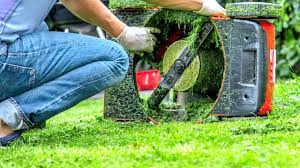
Post-Mowing Season Lawnmower Maintenance: Secure Your Mower’s Health for Next Spring
As the mowing season winds down and the chill of autumn sets in, it's time to think about tucking your lawnmower away until spring. But before you bid farewell to your trusty grass-cutting companion, a proper send-off in the form of maintenance is crucial. At Antego Tire & Wheel, we understand that a well-maintained mower means a happy, healthy lawn. Here’s our comprehensive guide to post-mowing season lawnmower maintenance to ensure your machine rests easy and is ready to spring into action when the warmer weather returns.
Clean It Up
Grass clippings, dirt, and debris can stick to your mower over the mowing season, leading to corrosion and clogging. Use a hose to wash off any clumped grass from the undercarriage, and wipe down the exterior surfaces. Make sure the mower is dry before storing it to prevent rust.
Change the Oil
Just like any other engine, your lawnmower’s engine oil needs to be changed regularly. After a full season of mowing, it's filled with contaminants that can damage the engine. Drain the old oil and replace it with fresh oil suited for your mower’s engine type.
Refresh the Fuel System
Old fuel can become stale and may lead to starting problems next season. Drain the tank or run the engine until it stops. For extra protection, add a fuel stabilizer to the fresh fuel you'll add next spring, which will keep the fuel fresh and ensure an easy start.
Inspect and Replace the Air Filter
A dirty air filter can reduce the efficiency of your engine and cause it to use more fuel. Clean or replace the air filter, following your manufacturer's recommendations. This small step can prolong your engine's life and improve performance.
Sharpen the Blades
Dull blades tear rather than cut the grass, which can lead to an unhealthy lawn. Sharpening your mower's blades at the end of the season ensures you'll be ready for that first cut in the spring. If the blades are too worn down, it's also a good time to replace them.
Check the Spark Plug
A faulty spark plug can cause many problems, from a rough-running engine to a mower that won't start. Remove the spark plug, inspect it for wear or damage, and clean it. If it's been a couple of years, you might want to replace it even if it looks fine.
Review the Tires
Your mower's tires can affect how evenly it cuts and how well it maneuvers. Check for wear and tear, and ensure they are inflated to the correct pressure. If the tires are worn out, it's time to replace them. Antego Tire & Wheel has a range of tires to fit various models, ensuring your mower glides smoothly over your lawn when it's time to get back to work.
Tighten Bolts and Handles
Vibration from mowing can loosen bolts and handles over time. Go over your mower and tighten them up. This will help reduce wear and tear and keep your mower stable and secure.
Battery Care
If your mower has a battery, make sure it’s fully charged before storing. For lead-acid batteries, it’s best to store them off the ground and charge them periodically throughout the off-season.
Proper Storage
Store your mower in a clean, dry place such as a garage or shed to protect it from the elements. If you don’t have an indoor space, cover the mower with a waterproof cover.
Record Keeping
Keep a record of all maintenance activities. Noting down what you’ve done will make it easier to keep track of when parts need to be serviced or replaced.
By taking these steps to care for your lawnmower at the end of the mowing season, you're not only protecting your investment but also setting yourself up for a trouble-free start next year. At Antego Tire & Wheel, we're committed to helping you maintain your lawn care equipment in top condition. Explore our selection of tires and lawn care accessories that promise to keep your machinery running smoothly for seasons to come.
Remember, the key to longevity in your lawn care equipment is maintenance. Give your lawnmower the attention it deserves, and come spring, it’ll return the favor with reliable service and a beautifully manicured lawn.
Note: Always refer to your lawnmower’s owner’s manual for specific maintenance instructions related to your model. Each lawnmower has unique needs, and the manufacturer’s recommendations should always be your primary guide.



